For centuries, Middle Eastern nomads and Bedouins have used raw camel milk as their primary source of nutrients when crossing the desert, as well as when they lack access to other types of food.
In this article, I’ll share the health benefits of camel milk — a dairy beverage that you’ve likely never had before. I’ll also compare the nutritional aspects of camel milk vs. cow, goat and sheep milk, and point out why camel milk might be a viable alternative if you suffer from dairy allergies.
Additionally, I’ll introduce you to Desert Farms, my favorite brand for camel products, including fresh camel milk, camel milk powder and hump fat.
What Are the Health Benefits of Camel Milk?
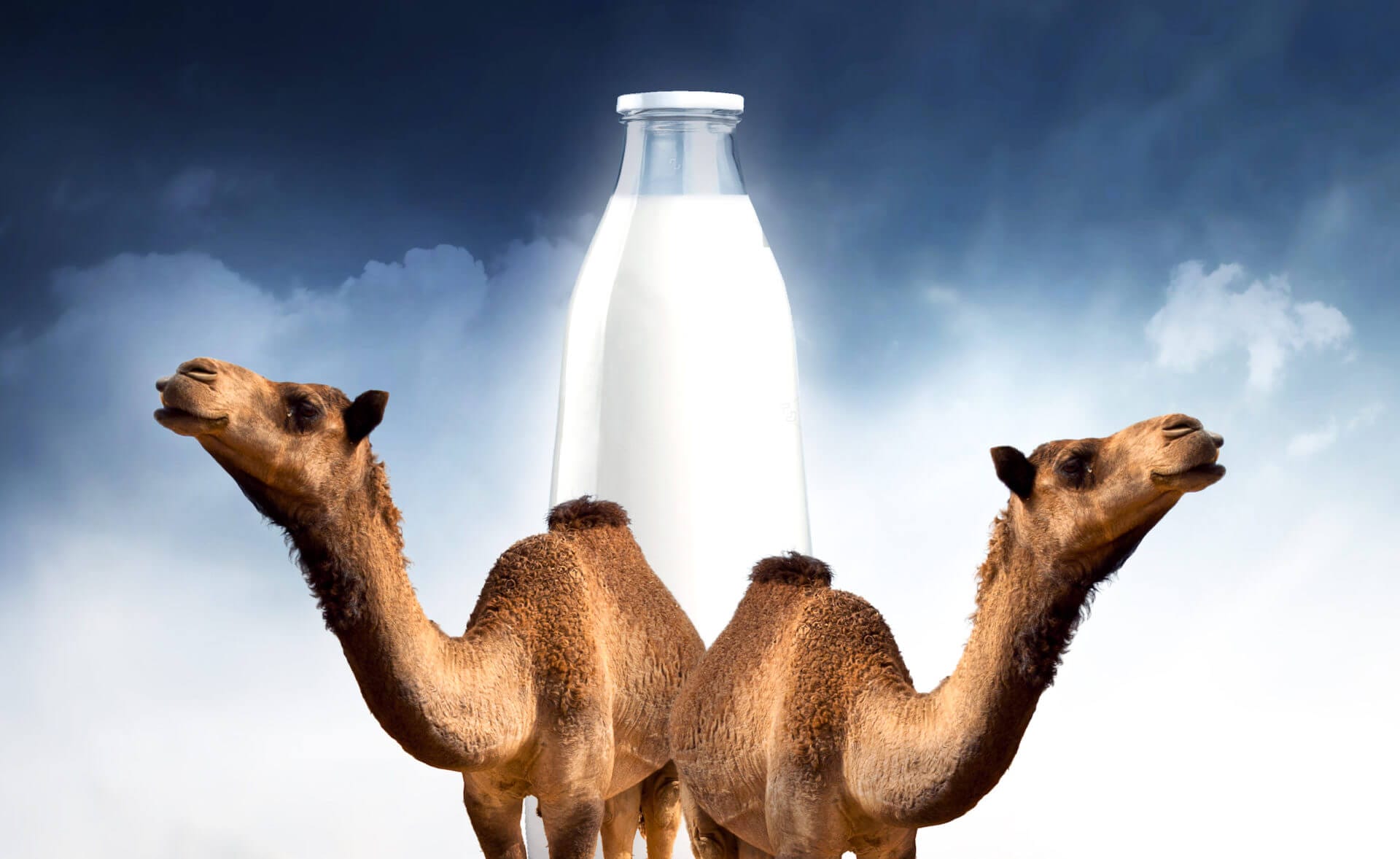
Camel milk has several scientifically-proven health benefits and properties, including:
- Insulin-like factors that prevent a spike in blood sugar.
- Its milk sugar (lactose) is easier to digest than that of cow milk.
- Has a non-inflammatory type of casein protein.
- Has colostrum-like properties thanks to lactoferrin and immunoglobulins.
- Is packed with micronutrients, including calcium, potassium and B vitamins.
Much like other sources of dairy, camel milk is rich in certain micronutrients, including calcium and B Vitamins. But unlike milk from other animals, camel milk is high in lactoferrin and immunoglobulins.
Lactoferrin is a beneficial protein that’s found in milk and other bodily fluids in the eye, nose, intestine and elsewhere. However, the highest concentrations are usually found in colostrum, the first milk produced after a baby is born.
That’s one of the reasons why colostrum is so effective at supporting the immune system, regulating the absorption of iron, and reducing the chance of bacterial infections.
Immunoglobulins are antibodies that are also commonly found in breastmilk. They support the immune system in neutralizing pathogens, such as bacteria and viruses. Camel milk is rich in immunoglobulins, which gives this milk similar properties as colostrum.
Additionally, camel milk contains insulin-like factors that discourage your pancreas from releasing additional insulin after consuming carbohydrates. Normally, you would see a massive spike in blood sugar (followed by a release of insulin) after drinking milk. That’s because milk, including camel milk, contains milk sugar (lactose).
However, after drinking camel milk you can expect much lower blood glucose and insulin levels. I tested this by drinking a cup of camel milk in a fasted state, and the results were surprising (see below).
The two other important benefits of camel milk are related to its protein and milk sugar.
Most cow’s milk has a protein called casein, and more specifically, casein beta A1. That’s the protein you’re likely allergic to if you suffer from any dairy allergy. Camel milk (much like goat and sheep milk) contains casein beta A2, which doesn’t trigger the same gastrointestinal symptoms.
But even if you’re not knowingly allergic to A1 casein, your body might still respond to the consumption of this protein with inflammation. That’s why I predominantly buy cheeses made from goat and sheep milk.
More common than milk protein allergies is a condition commonly known as lactose intolerance. This condition is triggered when your body doesn’t have enough lactase (the enzyme that helps metabolize lactose).
What most people don’t know is that declining lactase levels as we age is entirely normal because evolution didn’t intend for humans to consume milk beyond infancy.
As a result, the levels of lactase in babies decline after they’re weaned from the breast. That’s why most adults can’t metabolize lactose efficiently, even though not everyone will notice severe symptoms after consuming dairy products that contain milk sugar.
The good news for dairy lovers is that the lactose in camel milk is much easier to digest than that of other sources of milk — perhaps with the exception of sheep milk, which is also relatively easy to digest.
Nutrients in Camel Milk
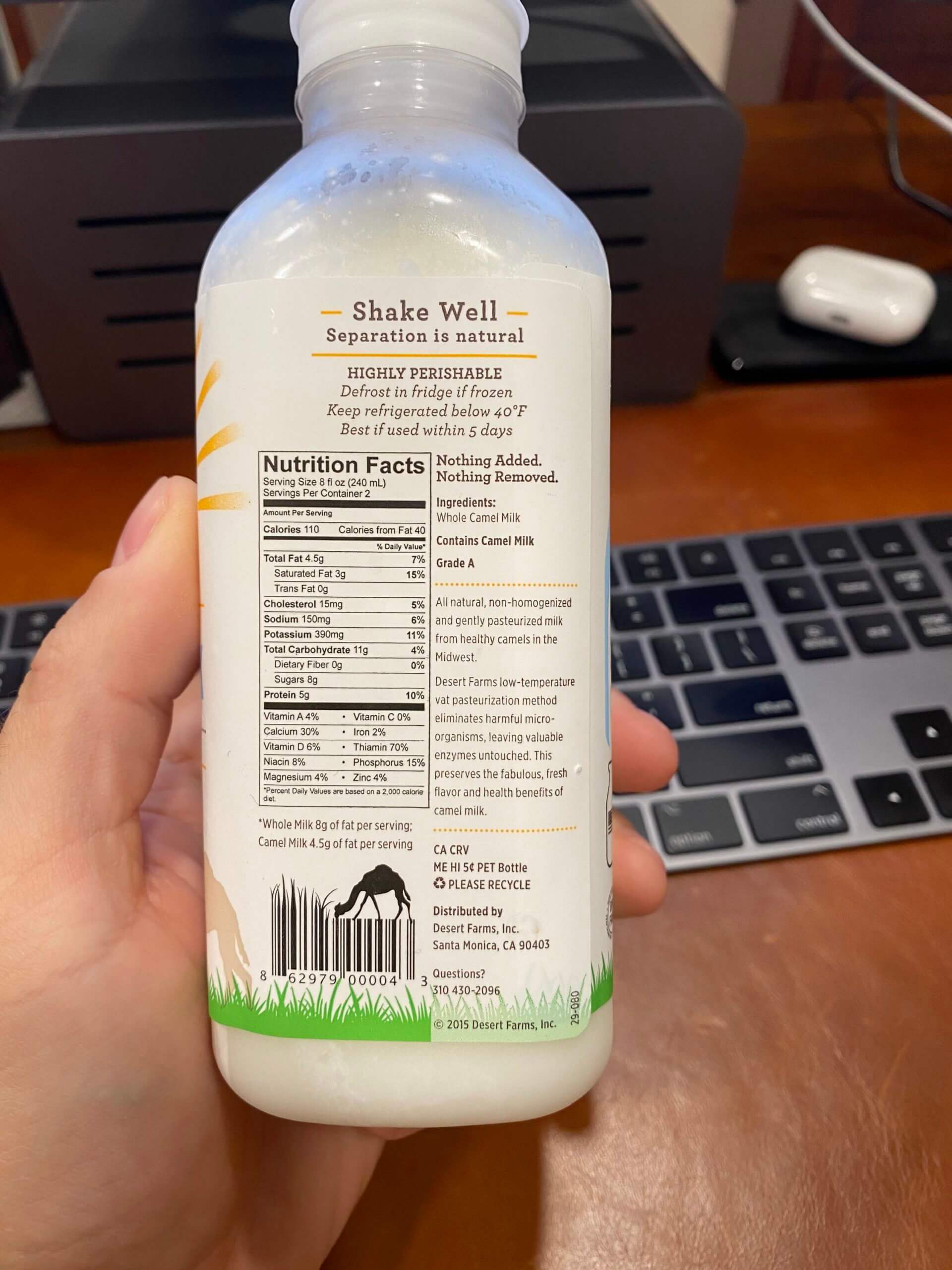
Fresh camel milk is relatively nutrient-dense, as you can see in the table below.
| Calories | 110 |
| Total fat | 4.5 grams |
| Total carbohydrates | 11 grams |
| Sugar (lactose) | 8 grams |
| Protein | 5 grams |
| Beneficial peptides | Lactoferrin, immunoglobulins |
| Vitamins | Vitamin A (4%), vitamin B1 (70%), vitamin B3 (8%), vitamin D (6%) |
| Minerals | Calcium (30%), iron (2%), phosphorus (15%), zinc (4%) |
One thing that you might notice is that camel milk is a little thinner than regular whole or full-fat milk. That’s because camel milk naturally contains about 40% less fat than cow milk.
Personally, I wouldn’t mind some extra calories from healthy fats, but I don’t think the milk’s lower fat content negatively impacts its taste much.
How Does Camel Milk Taste?
Everyone who I asked to try camel milk confirmed that it tastes just like cow milk.
I know the thought of drinking milk that came from a camel might feel odd to you, because it’s not an experience you’ve ever had. But I promise you that after taking your first sip, you’ll love it — assuming you like the taste of milk in general.
How Does Camel Milk Compare to Other Dairy Sources?
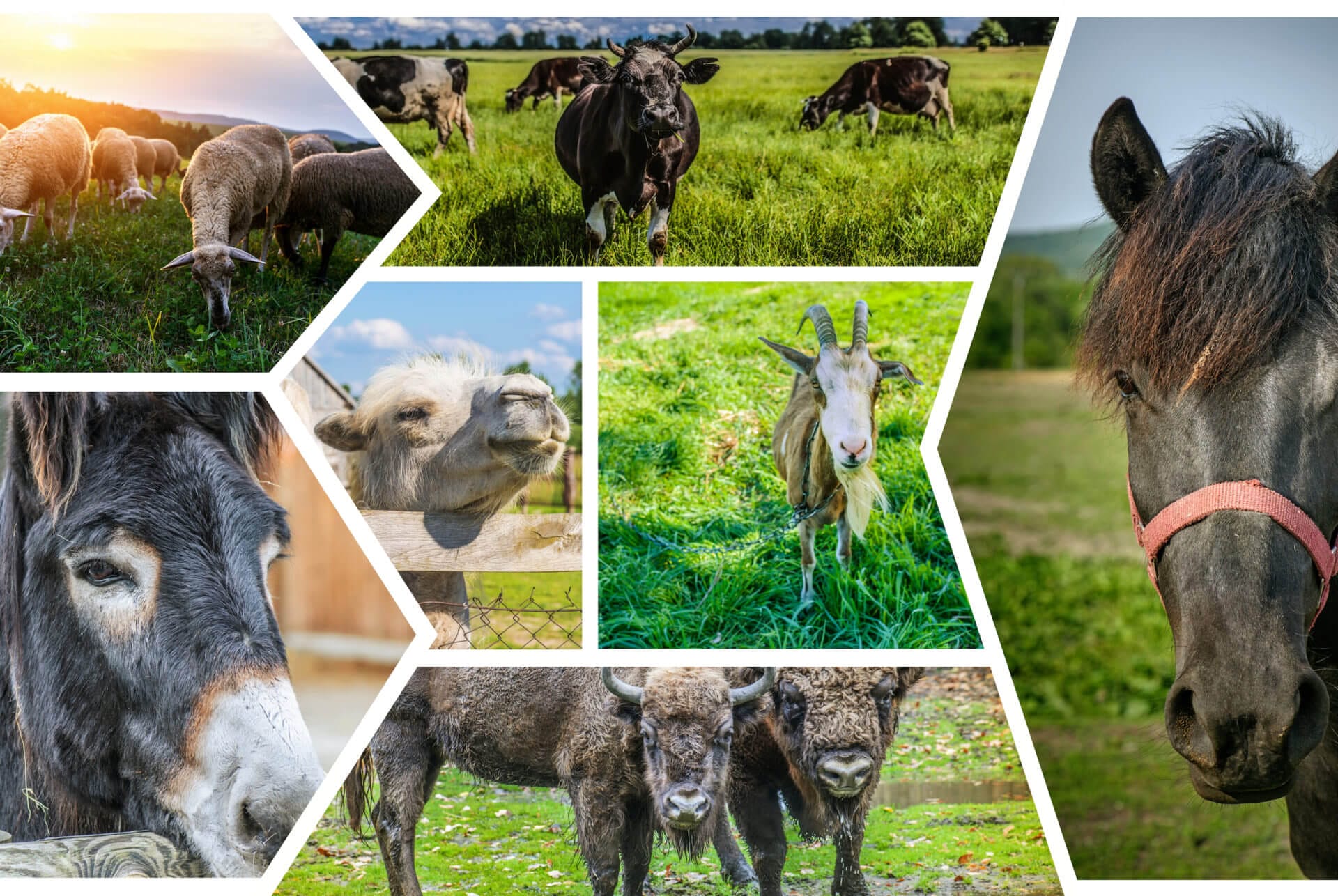
| Camel | Cow | Goat | Sheep | |
| Carbohydrates | 11g | 13g | 10g | 13g |
| Sugars | 8g | 13g | 11g | 12g |
| Protein | 5g | 8g | 11g | 15g |
| Fat | 4.5g | 8g | 9g | 17g |
| Micronutrients | ★★★ | ★★☆ | ★☆☆ | ★★☆ |
| Digestibility | ★★★ | ★☆☆ | ★★★ | ★★★ |
| Taste | ★★★ | ★★★ | ★★☆ | ★★☆ |
Camel Milk vs. Cow Milk

Cow milk is often touted as a healthy and nutritious beverage, rich in protein and calcium that helps kids grow strong bones.
But the truth is that the human body is not properly equipped to metabolize cow’s milk, making it a less than an ideal food for kids and adults alike.
The main issue with most cow milk is that it contains an inflammatory type of protein (casein beta A1) and a type of milk sugar that most people can’t digest properly.
As discussed above, camel milk contains a more digestible type of lactose and a type of protein that hasn’t been shown to be inflammatory.
Additionally, cow milk has more carbs and sugar but also more fat and protein overall. While I consider the extra fat a good thing, the higher protein content comes with some issues.
However, it’s worth noting that there are (dairy) cows that produce milk with A2 casein. So if you’re not sensitive to milk sugar and prefer cow’s milk, look for A2 milk.
I haven’t seen it in stores around Atlanta yet, but I recently stumbled across cheese made from grass-fed A2 milk at Costco!
One thing that cow milk certainly has going for it is the price. Half a gallon of grass-fed whole milk costs $6 or less — a fraction of the price of camel milk.
How Much Is Camel Milk?
Camel milk costs approximately $18 per 16-ounce bottle. That’s much more than you would pay for a container of cow’s milk.
But why is that?
The main reason is the economy of scale and the limited supply of the product in the United States. Domestic dairy cows outnumber camels by a ratio of 18,000:1. Plus, raising camels is more expensive, and their pregnancies last longer (around 13 to 14 months).
In other words, camel breeding in the U.S. is currently still a small/family farm business. For the sake of the well-being of all domestic camels, I sincerely hope it stays that way and doesn’t deteriorate in the same manner as the overall dairy industry, which is dominated by overcrowded feedlots and grain-fed animals.
Where Can You Buy Camel Milk?

We get all of our camel products from a company called Desert Farms. They’re located in the United States and they source their camel milk from small farms across the country.
Besides fresh camel milk, the company also offers the following products:
- Frozen camel milk
- Powdered camel milk
- Camel milk kefir (a fermented, probiotic drink without lactose)
- Camel (hump) fat — one of the best cooking oils
I stumbled across Desert Farms when I attended the Paleo f(x) tradeshow in 2019 and got hooked on their camel fat, which we’ve used since for high-heat cooking.
Buy Directly from Desert Farms
Camel Milk and The Ketogenic Diet
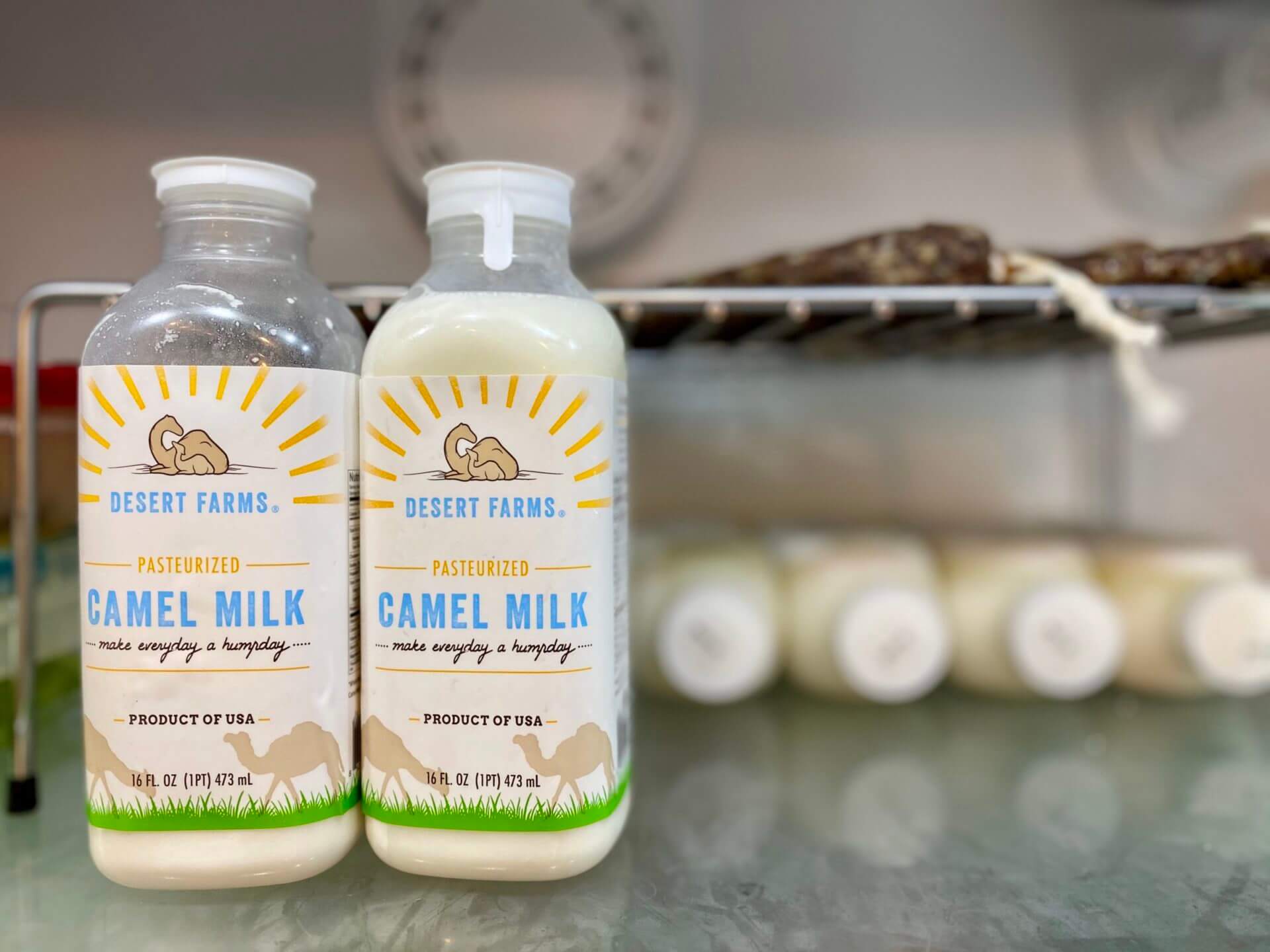
If you’ve been on keto for a while, you probably know that dairy milk is generally not considered to be a keto-friendly product.
So if you had asked me whether camel milk is keto-friendly before I started working on this article, I would have answered with a definitive “no.”
Think about it: how can camel’s milk that contains 8 grams of sugar and only 4.5 grams of fat be considered keto?
Well, it turns out that the camel milk from Desert Farms is actually keto-certified. And if you look at the certification’s requirements, you’ll see that camel milk has fewer net carbs than what’s permitted by the standard.
However, that doesn’t mean you can drink a gallon of camel milk per day and expect to stay in ketosis. So I recommend consuming it in moderation only.
To find out exactly how my body would respond to a cup of camel milk, I took blood glucose and ketone readings after a 14-hour fast and before consuming the milk. That was my baseline.
After that I took three more readings; one each at the 30, 60 and 90-minute mark.
Here are the results:
| Glucose (mg/dL) | Ketones (mmol/L) | |
| Baseline | 82 | 1.1 |
| 30 mins | 97 | 1.1 |
| 60 mins | 90 | 0.6 |
| 90 mins | 87 | 1.0 |
As you can see, my blood sugar spiked marginally but remained below normal fasting levels (75-99). My blood ketone levels dropped with a small delay, but I remained in nutritional ketosis (above 0.5 mmol/L). At the 90-minute mark, I was practically back to baseline.
These results tell me two things:
First, that I can consume camel milk in moderation without getting kicked out of ketosis. And second, that my metabolism is incredibly flexible and easily bounces back and forth between using different fuel sources.
Info: According to this study published on the NIH website, metabolic inflexibility can cause a nutrient overload, impaired fuel switching, and energy dysregulation. The latter is incredibly important. You don’t want to be in a position where your body can’t efficiently metabolize the fuel you’re providing (be it fat or carbs).
If you want to learn more about how to increase your metabolic flexibility, read my review of Lumen, a metabolic breath analyzer that I tested.
Frequently Asked Questions
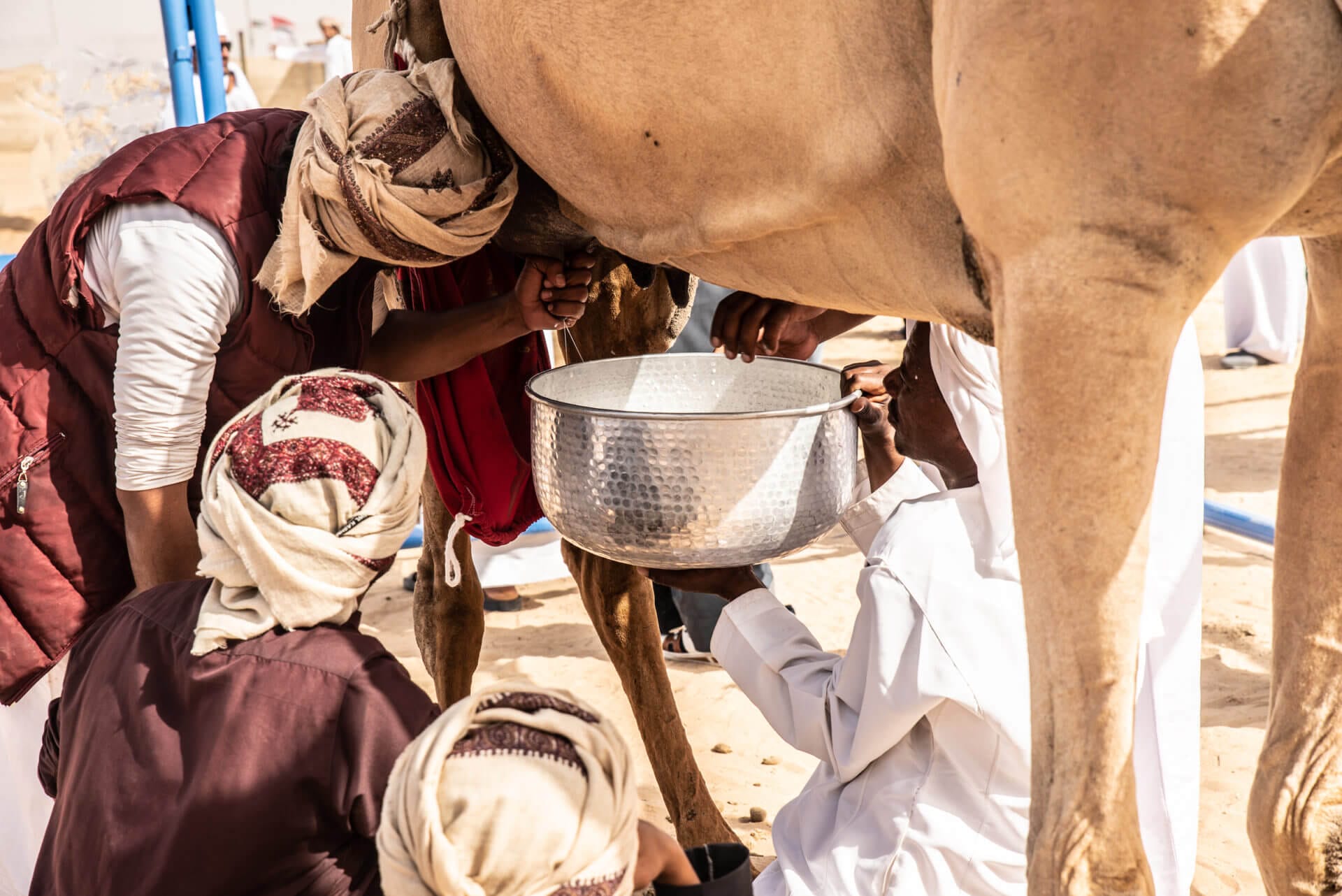
No. Dairy products are, by definition, not paleo-friendly because our Paleolithic ancestors didn’t start domesticating animals (and consuming their milk) until about 10,000 years ago — long after the Paleolithic era had ended.
Raw and unpasteurized camel milk, much like any other milk, can make you sick if it’s contaminated with pathogens.
That’s why the Food and Drug Administration (FDA) issued an ordinance that mandates the “pasteurization for all milk and milk products in final package form intended for direct human consumption.”
Pasteurized milk (regardless of its source) is generally safe for consumption.
Desert Farm uses a relatively gentle low-heat pasteurization method that preserves as many nutrients as possible under the current law.
Personally, I certainly recognize the benefits of pasteurizing milk for mass consumption. But I also recognize that consuming raw dairy products from trusted sources can be perfectly safe. I grew up on raw cow’s milk and fresh eggs that were never washed in chlorine or refrigerated. We just trusted the local farmer we purchased the products from.
Neither camel milk nor cow milk contains vitamin C, but both goat and sheep milk do.
Most of the fat in camel milk consists of monounsaturated fatty acids, and omega-9 in particular. The milk also has some omega-3 and omega-6 unsaturated fatty acids at a ratio of almost 1:1.
Considering that camel milk contains insulin-like factors that prevent huge spikes in blood sugar, some studies have suggested that camel milk could be a viable alternative for people who are diabetic.
Honestly, if I had Type 2 diabetes, I would stay as far away from any carbs, and especially sugar, as I possibly could. Instead, I’d be on a very strict ketogenic diet limiting my daily carb intake to 10-20 grams until I’m cured of the disease.
Of course, you could use your daily carb allowance on a cup of camel milk and you’d most likely be fine. Personally, I’d spend my carb allowance on a cauliflower crust pizza, but that’s just me.
I’m sure you can, but I’ve never tried. If you do, let me know how it tastes!
Temporarily, I’m sure you can. That’s what Bedouins and nomads often do while crossing the desert. However, I don’t think anyone has ever tried drinking only camel milk for longer periods to see how the body would react.
Yes, in fact, most of the protein in camel milk is whey, which is a good source of bioactive peptides (the structures that make up protein molecules).
I don’t like the term “superfood” because it’s most commonly used to describe a plant-based food that’s rich in certain nutrients. However, what most people conveniently ignore (or don’t know) is the fact that those very plants are also rich in antinutrients or other chemical compounds that aren’t particularly healthy.
A good example is chia seeds. Yes, they’re packed with omega-3 fatty acids and minerals. But they’re also rich in antinutrients that prevent the body from absorbing those minerals.
That doesn’t make chia seeds all bad (if prepared properly), but they’re a far cry from a superfood.
I think that camel milk can have its place as part of a healthy diet (even the ketogenic diet) due to its nutritional value. But I wouldn’t call it a superfood.
How Healthy Is Camel Milk? Final Thoughts
If you’d like to make dairy milk part of your diet, then camel milk is one of the best choices because it’s easier to digest than cow milk and is loaded with micronutrients and enzymes that you won’t often find in other dairy products.
What definitely surprised me was how keto-friendly camel milk is. For this review, Desert Farms sent me over 24 bottles of milk. And while I gave away some of them to friends and workout buddies, I drank most of them at a rate of about one bottle a day.
Needless to say, I remained fully in ketosis and my blood sugar never spiked beyond fasting levels.
Overall, I appreciated that I could add camel milk to my mix of daily beverages that usually includes only water, black coffee, home-brewed water kefir and a glass of wine (in the evening).
If you’ve never tried camel milk before but love dairy milk and are looking for a healthier alternative, check out Desert Farms and let me know how you liked the milk by leaving a comment below.

Michael is a healthy living enthusiast and CrossFit athlete whose goal is to help people achieve optimal health by bridging the gap between ancestral living and the demands of modern society.
Medical Disclaimer
The information shared on this blog is for educational purposes only, is not a substitute for the advice of medical doctors or registered dieticians (which we are not) and should not be used to prevent, diagnose, or treat any condition. Consult with a physician before starting a fitness regimen, adding supplements to your diet, or making other changes that may affect your medications, treatment plan or overall health. MichaelKummer.com and its owner MK Media Group, LLC are not liable for how you use and implement the information shared here, which is based on the opinions of the authors formed after engaging in personal use and research. We recommend products, services, or programs and are sometimes compensated for doing so as affiliates. Please read our Terms and Conditions for further information, including our privacy policy.
Michael, thanks for writing this in-depth article on camel milk! Super helpful, and one of the best articles I’ve read. I work for camelculture.org so I’ve read a lot of them! haha.
Hi, I have read a few websites on camel milk, and I love Desert Farms! One question I have is about vitamin C. On another site, they say that camel milk does contain vitamin C. Coments?
I have never heard of Vitamin C in camel milk (or other type of dairy).
Why bother with camel milk when you can go for almond milk? Far less carbs!
Hi Skeptic,
Raw almonds (and thus almond milk) are rich sources of oxalates, which are plant-based toxins that prevent mineral absorption, can cause kidney stones, inflammation and other issues. I’d rather have some sugar over toxins, but that’s a personal preference.
Almonds also have massive amounts of omega-6
Almond milk isn’t milk. Its blended water and almonds. Should answer your question.
Thank you so much for this informative article! I recently have made the switch to camel milk because I’m on a low carb diet and it has less sugars than cows milk but still tastes like it (the nut milks just don’t have the same effect). I particularly appreciate the fact that you tested if it would spike your blood sugars!! That info blew my mind. I’ve been using it in my avocado smoothies and it is wonderful!
Hi Isha,
Thanks for your feedback, I appreciate it!